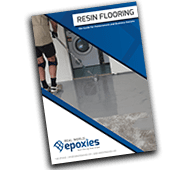Home › Advice › Know How › Knowhow
Epoxy Flooring Troubleshooting - Solvent Entrapment
What is solvent entrapment and why is it bad news for two-pack epoxy coatings?
If you thought solvent entrapment had something to do with solvent becoming trapped in a
film then you’d be 100% correct. There’s nothing tricky about the name, that’s for sure! Just like anything though, knowing what it is
and what it looks like is the easy part; knowing why it happens and how to avoid is where the gold really lies.
Basically, solvent entrapment can be boiled down to one thing: the solvent not having enough time to evaporate from the film before the hardening process goes too far. When applied correctly, two-pack epoxies containing solvent normally have enough time before this happens, however if they’re applied too thick or in cooler, damper conditions, the components can crosslink before the solvent escapes and this can lead to a variety of problems.
Although solvent entrapment can happen in solvent-based or water-based products, the way it affects the film is more a factor of how much solvent is used rather than the type of epoxy.
Solventless epoxies and solvent entrapment
As I’ve already written in a previous post (Solvents
and their purpose in solventless epoxies),
some solventless epoxies can have a small volume of solvent added to extend pot life or drop viscosity. Despite the very low solvent
content (typically 5% or less), solvent entrapment can still be an issue and tends to compromise a film in two ways:
-
Soft spots - Solvent trapped in the film can create a
physical barrier to crosslinking in isolated sections and stop these spots from fully hardening (hence the term “soft spots”). This
phenomenon is even more likely if acetone or MEK is used because they belong to a group of solvents called ketones that block the
chemical reaction with the amine.
- Blistering - If the solvent has a relatively high boiling point and won’t evaporate quickly then you not only raise the risk of trapping it in the first place, but you’re also more likely to see blisters develop. This happens because solvents with higher boiling points are often hydrophilic, which means they attract water and could draw enough to form visible blisters.
Solvent-borne, water-borne epoxies and solvent entrapment
If those are the main dangers of low-level solvent entrapment in two-pack epoxies, what happens when the solvent content is much higher, for
example 70% in a solvent-borne or water-borne epoxy? In this situation, you typically see a different outcome. Rather than a small pocket of
solvent permanently held captive in the film, the majority manages to gradually work its way out as the film tries to crosslink and what you
end up with is a porous, sponge-like structure across widespread areas. Instead of a strong, hard film, you’re left with a much softer,
weaker version that is also commonly affected by a large number of shrinkage cracks (called “mudcracking”).
It’s important to mention at this point that extra care must be taken with water-borne products and entrapment problems because of the lower
volatility risk I touched on in my comments on blistering. Water will not evaporate as quickly as organic solvents and therefore these kinds
of products are more prone than others.

Solvent entrapment traps
OK, so you’re probably thinking, “If I stick to applying as per the manufacturer's specification, I should not run into trouble, right?” In
theory that’s correct, but sometimes it isn’t always that straightforward. For instance, what happens on a slab with minor depressions such
as small gouges that exceed the allowed thickness? That’s just one scenario where you could unwittingly be heading for a problem and the
only way you could avoid costly defects there is to have a good understanding of why solvent entrapment occurs in the first place.
-
Products - Use a range of solvent-free (100% solids) epoxy and polyurethane coatings that eliminate the risk of
solvent entrapment:
- Real World Epoxies Product Range
-
Learning - Learn more about the causes of solvent entrapment, and how to avoid it, with our online courses:
- Epoxy Flooring Short Courses
- Bronze Card Course
- Silver Card Course
-
Ask a question - If you have any questions you'd like to ask us about this topic, hit the support button below:
_800x271a.png)
